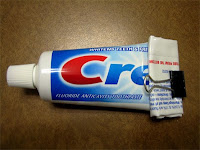 We've all seen that commercially prepared woodputty is often sold in cans with the lid on the bottom - to open you have to invert it, and to store later with an upright appearance, you have to sit it back on the lid. Makes sense - the product goops itself to the bottom / lid, sealing the can, preventing air exchange & keeping it fresher, longer. Lots of condiments like catsup and mayo and so forth are coming that way these days too - same sort of reasoning. Trap a minimum amount of air and use the product to seal the container. I do something similar with cans of finishes / paint - after I get the lid down tight, I swirl the can around so that finish contacts the entire area of the join between the lid and the can, hopefully sealing it better than just the metal-to-metal connection of can and lid, even if I don't invert.
We've all seen that commercially prepared woodputty is often sold in cans with the lid on the bottom - to open you have to invert it, and to store later with an upright appearance, you have to sit it back on the lid. Makes sense - the product goops itself to the bottom / lid, sealing the can, preventing air exchange & keeping it fresher, longer. Lots of condiments like catsup and mayo and so forth are coming that way these days too - same sort of reasoning. Trap a minimum amount of air and use the product to seal the container. I do something similar with cans of finishes / paint - after I get the lid down tight, I swirl the can around so that finish contacts the entire area of the join between the lid and the can, hopefully sealing it better than just the metal-to-metal connection of can and lid, even if I don't invert. Another method is to reduce the size of the container as the product is used - toothpaste and caulk spring to mind, but I am also reminded of collapsible containers like those used in darkrooms to store chemicals and the mylar bag that makes boxes of wine possible, if not necessarily desirable. I guess for completeness, you can also put displacement in this category - like putting a brick in a toilet to reduce water usage, but keep the water level up. My favorite submethod is to simply move smaller amounts into smaller containers.
Another method is to reduce the size of the container as the product is used - toothpaste and caulk spring to mind, but I am also reminded of collapsible containers like those used in darkrooms to store chemicals and the mylar bag that makes boxes of wine possible, if not necessarily desirable. I guess for completeness, you can also put displacement in this category - like putting a brick in a toilet to reduce water usage, but keep the water level up. My favorite submethod is to simply move smaller amounts into smaller containers.The third solution is to remove as much air as possible / vacuum pack things - with the use of a pump & containers that seal really well.
 The method I've been thinking about today is another sort of displacement, suggested by my buddy Mike. Instead of displacing product, why not displace the air? There are plenty of inert gasses that are heavier than air. Just "pour" a heavy inert gas into a container, forming a gas lid on the surface, blocking any interaction. Makes me recall the wax lids on the surface of my Grandmother's homemade jellies. There are commercial products available for doing this for wine, and now, for woodworking. Private Preserve is the original method for wine & is composed of argon, carbon dioxide and nitrogen. If you already have some, you can use it in your cans in the shop (and darkroom) too! But Bloxygen is used in exactly the same way (although it appears that it contains just argon from what it says on the label) for about the same price and may be already available in your local woodworking store. And hey, who wants to go to a wine store when you can go to a woodworking store?
The method I've been thinking about today is another sort of displacement, suggested by my buddy Mike. Instead of displacing product, why not displace the air? There are plenty of inert gasses that are heavier than air. Just "pour" a heavy inert gas into a container, forming a gas lid on the surface, blocking any interaction. Makes me recall the wax lids on the surface of my Grandmother's homemade jellies. There are commercial products available for doing this for wine, and now, for woodworking. Private Preserve is the original method for wine & is composed of argon, carbon dioxide and nitrogen. If you already have some, you can use it in your cans in the shop (and darkroom) too! But Bloxygen is used in exactly the same way (although it appears that it contains just argon from what it says on the label) for about the same price and may be already available in your local woodworking store. And hey, who wants to go to a wine store when you can go to a woodworking store?




